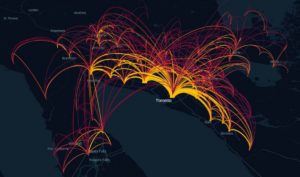Accurate data is one of the most fundamental tools in any public safety agency’s arsenal against COVID-19. And who better to provide health experts with a wealth of information than a social networking giant with 2.5 billion active users?
Last year, Facebook’s Data for Good team introduced a free data platform called Disease Prevention Maps to improve health outcomes for communities around the world. The company offered nonprofits and humanitarian agencies a rich suite of map products developed using aggregated data to protect people’s privacy. These map products included:
- High-resolution population density maps with demographic estimates
- Population movement maps
- Cellular network coverage maps
Read more: Why Facebook’s disease prevention maps are important
Now, with the coronavirus crisis bringing the world to its knees, Facebook is bringing out three new types of Disease Prevention Maps to help inform disease forecasting efforts and protective measures.
Social Connectedness Index
By displaying friendships and social ties across states and countries, Facebook aims to help epidemiologists forecast the likelihood of the spread of the novel coronavirus. This dataset could also be used to identify which areas might seek support as they are hit by COVID-19. For example, below you can see how connected different parts of the US are to the East Village, New York, on Facebook:

Co-location Maps
These maps reveal the probability of people in one area coming in contact with people from another area, thus helping healthcare agencies and disease modelers to understand where COVID-19 cases may appear next. The image below shows co-location patterns in Italy:

Movement Range Trends
Curated at a regional level, these maps show whether people are staying near home or visiting many parts of town. This information can prove pivotal in providing insights into whether preventive measures are headed in the right direction or not. Below, you can see the movement range trends for Brazil:

As with the map products before, the new Disease Prevention Maps aggregate information from Facebook, ensuring that people’s identities are hidden and reducing the risk of anyone being re-identified.
Explaining how valuable the information Facebook is offering could be in responding to the coronavirus pandemic, Daniel Klein, Ph.D., Institute for Disease Modeling, says, “COVID-19 has inherent delays that challenge the pace at which we seek to evaluate policy impact towards a measured response. Mobility data from Facebook’s Data for Good program provides a near real-time view of important correlates of disease transmission. This data, in combination with other sources, allows us to make better models to inform public health decisions.”
Facebook’s anti-corona measures also include encouraging people in the US to participate in a voluntary survey from Carnegie Mellon University Delphi Research Center, which has been designed to help health researchers identify COVID-19 hotspots earlier. If the results are helpful, Facebook will make similar surveys available in other parts of the world as well.











